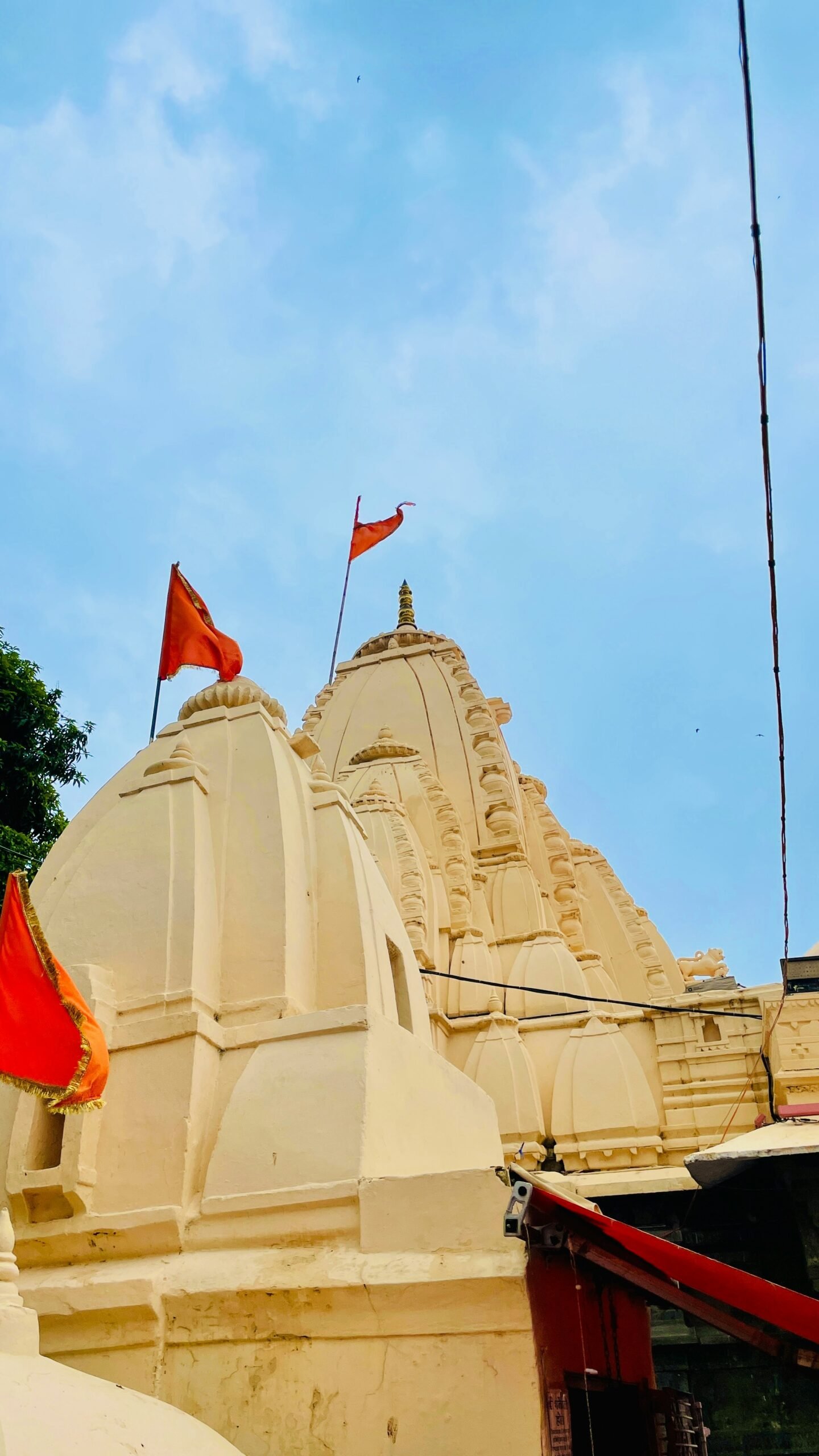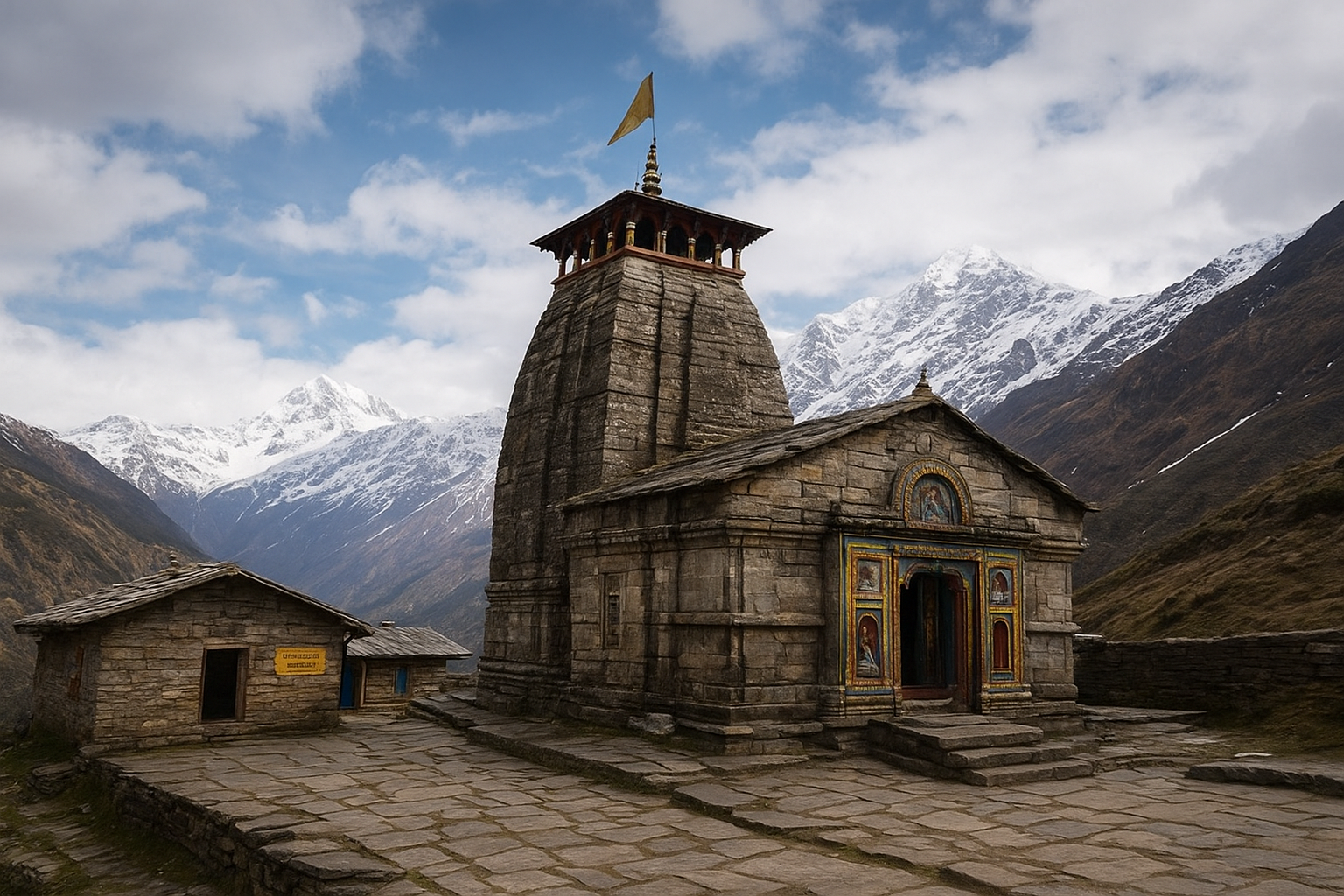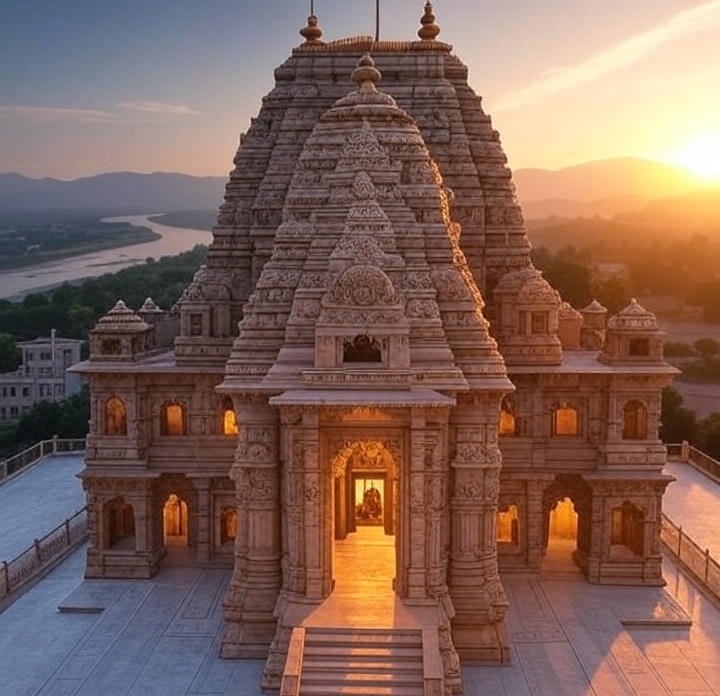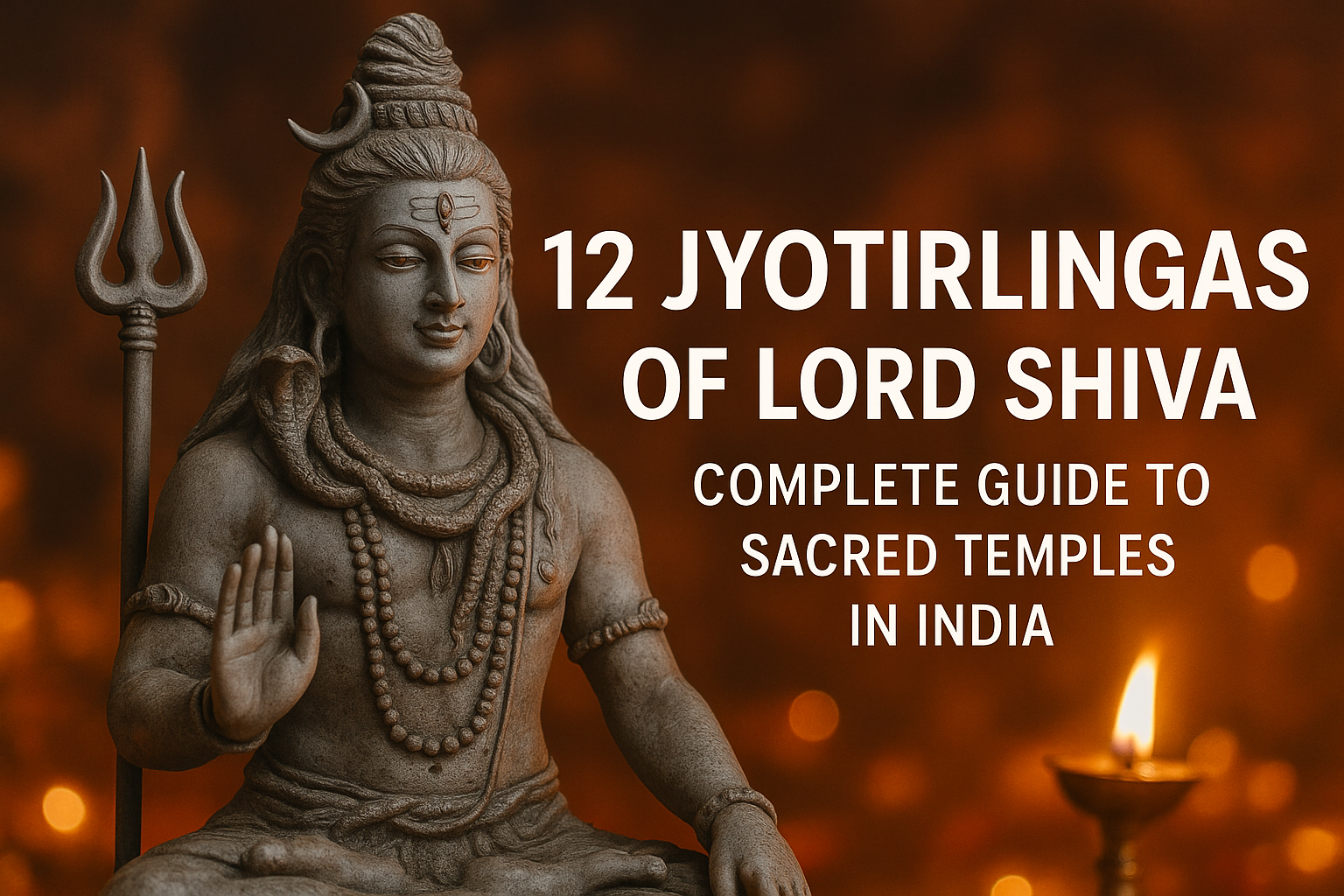Introduction to Jyotirlingas
The Jyotirlingas are a group of twelve sacred shrines dedicated to Lord Shiva, one of the principal deities in Hinduism known for his roles as the destroyer and transformer within the Trimurti, alongside Brahma and Vishnu. The term “Jyotirlinga” is derived from two Sanskrit words: “Jyoti,” meaning light, and “Linga,” which represents the sacred symbol of Lord Shiva. Therefore, a Jyotirlinga is essentially a radiant symbol of Shiva, believed to manifest his infinite nature and divine presence.
In Hindu cosmology, Jyotirlingas are considered highly sacred due to their divine origin and mystical powers. According to ancient scriptures like the Shiva Purana and the Linga Purana, these twelve sites are where Lord Shiva appeared as a column of light, symbolizing his boundless energy and divine essence. Each Jyotirlinga is said to have a unique story and significance, deeply rooted in mythology and local folklore, contributing to its spiritual importance.
Devotees believe that worshipping at these Jyotirlingas can absolve them of their sins and grant them salvation, or moksha. Pilgrimages to these sacred sites are considered highly auspicious, and they attract millions of worshippers from around the world each year. The spiritual ambiance of these shrines, combined with their historical and architectural grandeur, makes them pivotal centers of devotion and pilgrimage.
Lord Shiva’s connection to these divine shrines underscores his role as the ultimate source of cosmic energy and spiritual enlightenment. The Jyotirlingas serve as powerful reminders of Shiva’s omnipresence and his ability to transcend time and space. By understanding the profound significance of these shrines, one can appreciate the depth of devotion and reverence that followers of Hinduism associate with the 12 Jyotirlingas, setting the stage for a detailed exploration of each sacred abode.
Somnath Jyotirlinga, Gujarat
The Somnath Jyotirlinga, located in Prabhas Patan near Veraval in Saurashtra, Gujarat, stands as a revered emblem of spiritual heritage and architectural splendor. This sacred shrine is the first among the twelve Jyotirlingas of Lord Shiva, making it a significant pilgrimage destination for devotees worldwide. The Somnath Temple has a rich historical and mythological backdrop, believed to have been built by Moon God (Soma) himself after being freed from a curse. This association with celestial mythology adds a layer of profound reverence to the site.
The temple’s architecture reflects Chalukya style, with intricate carvings and a majestic shikhara (spire) that rises to a height of around 50 meters. The temple’s design is not only a marvel of ancient craftsmanship but also a testament to the resilience and devotion of the Indian people, having been rebuilt several times after destruction by invaders. The current structure, completed in 1951, was initiated by Sardar Vallabhbhai Patel and stands as a testament to India’s cultural resurgence post-independence.
Legends associated with Somnath Jyotirlinga narrate its links with various historical figures and divine interventions, enhancing its mystical allure. One such legend speaks of Lord Krishna’s departure to his heavenly abode from the nearby Bhalka Tirtha. The confluence of history, mythology, and spirituality at Somnath makes it a unique pilgrimage experience.
Reaching Somnath is convenient with well-connected transport facilities. The nearest airport is Diu, about 90 kilometers away, and the closest railway station is Veraval, roughly 7 kilometers from the temple. Buses and taxis are readily available for the final leg of the journey.
The best time to visit Somnath is during the cooler months from October to March, when the weather is pleasant for exploration and spiritual activities. Festivals like Maha Shivaratri see the temple adorned with lights and thronged by devotees, offering a vibrant and spiritually enriching experience.
Mallikarjuna Jyotirlinga, Andhra Pradesh
Mallikarjuna Jyotirlinga, situated on the picturesque Srisailam Mountain by the Krishna River in Andhra Pradesh, stands as a beacon of spiritual significance and architectural splendor. This revered site is one of the 12 Jyotirlingas, making it a pivotal destination for devotees of Lord Shiva. The temple’s origins are steeped in antiquity, with historical records and local lore tracing its existence back to several centuries. It is believed that Lord Shiva and his consort Parvati manifested here as Mallikarjuna and Bhramaramba, respectively, to bless their devotees.
The architectural style of Mallikarjuna Jyotirlinga is a testament to the rich cultural heritage of the region. The temple complex is adorned with intricate carvings, towering gopurams, and beautifully sculpted pillars that reflect the Dravidian architectural ethos. The sanctum sanctorum houses the sacred Jyotirlinga, which is enshrined in a silver-plated altar, exuding an aura of divine energy. The temple also features several mandapams (halls) and shrines dedicated to various deities, providing a holistic spiritual experience for visitors.
Mallikarjuna Jyotirlinga holds immense importance in the Shaiva tradition. It is regarded as a place where devotees can attain moksha (liberation) and receive the blessings of Lord Shiva and Goddess Parvati. The temple is also associated with numerous legends, one of the most prominent being the tale of Shiva and Parvati’s visit to pacify their son Kartikeya, who had taken refuge on the Srisailam hill. Their presence is believed to have sanctified the place, making it an eternal abode of divine grace.
For those planning a visit, the temple is well-connected by road and can also be accessed via the nearest airports in Hyderabad and Vijayawada. The optimal time to visit Mallikarjuna Jyotirlinga is during the months of October to February, when the weather is pleasant. Additionally, the temple hosts several festivals, with Maha Shivaratri being the most celebrated, attracting throngs of devotees. Visitors are advised to dress modestly and adhere to the temple’s customs to ensure a fulfilling and respectful experience.
Mahakaleshwar Jyotirlinga, located in Ujjain, Madhya Pradesh, holds a distinguished place among the 12 jyotirlinga names with places. Revered for its immense spiritual significance, Mahakaleshwar is considered one of the most sacred abodes of Lord Shiva. The temple stands majestically on the banks of the Kshipra River and is deeply enshrined in Hindu rituals and traditions.
One of the most unique and sought-after experiences at Mahakaleshwar is the Bhasma Aarti, a ritual performed early in the morning where the deity is bathed in sacred ash. This ritual is attended by devotees from all over the world, making it a once-in-a-lifetime spiritual experience. The temple’s sanctum sanctorum houses the self-manifested Shiva linga, which is believed to bestow blessings and remove obstacles for those who offer their prayers with devotion.
The Mahakaleshwar temple is also steeped in mythological lore, with references found in ancient scriptures like the Puranas. According to one legend, the demon king Dushan was terrorizing the people of Ujjain. The citizens prayed to Lord Shiva, who appeared in his fierce Mahakal form to annihilate the demon, thus protecting the city. This act of divine intervention is commemorated through various rituals and festivals celebrated at the temple.
For travelers planning a visit, it is advisable to go during the cooler months from October to March. The temple is open from early morning until late at night, but the Bhasma Aarti requires prior registration due to its immense popularity. Ujjain is well-connected by rail and road, making it accessible for pilgrims and tourists alike. Accommodations range from budget lodgings to more comfortable options, ensuring a pleasant stay for visitors.
Overall, Mahakaleshwar Jyotirlinga in Ujjain offers a profound spiritual journey, enriched by its historic and cultural tapestry. Its role in Hindu rituals, distinctive features, and ancient stories make it a site of immense reverence and an essential stop on the journey to discovering the 12 jyotirlinga names with places.
Omkareshwar Jyotirlinga, Madhya Pradesh
The Omkareshwar Jyotirlinga, located on the serene Mandhata Island in the Narmada River, Madhya Pradesh, stands as one of the most sacred abodes of Lord Shiva. The name Omkareshwar is derived from the sacred syllable ‘Om,’ which is believed to symbolize the essence of the universe. This temple is an architectural marvel, showcasing intricate carvings that echo the spiritual resonance of its surroundings. The sanctum sanctorum houses the revered Jyotirlinga, drawing thousands of devotees and spiritual seekers annually.
One of the unique aspects of Omkareshwar is the dual concept of Omkareshwar and Mamleshwar temples. According to legend, both these temples represent two forms of the same Jyotirlinga. The Mamleshwar temple, located on the southern bank of the Narmada River, complements the spiritual significance of Omkareshwar. Together, they symbolize the unity of divine energy manifesting in dual forms.
The mythology surrounding Omkareshwar is rich and captivating. It is believed that the island itself is in the shape of the sacred ‘Om’ symbol, enhancing its spiritual allure. Legends narrate that once upon a time, King Mandhata performed great penance here, leading to the manifestation of Lord Shiva. Another legend speaks of the Vindhya mountain range performing rigorous penance to gain the blessings of Lord Shiva, resulting in the appearance of Omkareshwar Jyotirlinga.
For travelers planning a visit, Omkareshwar is well-connected by road and rail. The nearest railway station is Omkareshwar Road, located approximately 12 kilometers away. Visitors can also reach the temple via boat rides along the Narmada River, offering a picturesque and spiritual journey. The best time to visit is during the months of October to March, when the weather is pleasant. Devotees should adhere to temple guidelines, including dress codes and timings, to ensure a respectful and fulfilling pilgrimage experience.
Kedarnath Jyotirlinga, Uttarakhand
Nestled in the majestic Himalayas near the Mandakini River, Kedarnath Jyotirlinga holds a venerable position among the 12 Jyotirlingas in India. This sacred temple is perched at an altitude of 3,583 meters, making it one of the most remote and challenging shrines to access. Pilgrims often undertake a rigorous trek through rugged terrain to reach the temple, which is accessible only on foot, by pony, or via palanquin during the months of April to November. The arduous journey is a testament to the devotion of the countless worshipers who visit each year.
Kedarnath Jyotirlinga is not only significant as one of the 12 Jyotirlingas but also as an integral part of the Char Dham Yatra, a pilgrimage that includes Badrinath, Gangotri, and Yamunotri. This yatra is considered highly auspicious and spiritually rewarding, attracting devotees from across India and the world. The temple itself is believed to have been constructed by the Pandavas and later restored by Adi Shankaracharya in the 8th century.
The legends surrounding Kedarnath Jyotirlinga are deeply rooted in Hindu mythology. According to lore, after the Kurukshetra war, the Pandavas sought Lord Shiva’s blessings for redemption. Lord Shiva, seeking to avoid them, transformed into a bull and buried himself in the ground, leaving his hump visible. This hump is said to have manifested as the lingam worshipped at Kedarnath. The sanctity of the site is further underscored by the belief that a visit can absolve one of sins and lead to moksha (liberation).
For pilgrims planning to visit Kedarnath Jyotirlinga, it is advisable to prepare for the high-altitude conditions and unpredictable weather. Warm clothing, sturdy footwear, and a well-planned itinerary are essential for a safe and fulfilling pilgrimage. Additionally, ensuring physical fitness can significantly enhance the experience, allowing devotees to focus on the spiritual aspects of their journey to this revered Jyotirlinga.
Bhimashankar Jyotirlinga, Maharashtra
Bhimashankar Jyotirlinga, one of the revered 12 Jyotirlingas, is nestled in the Sahyadri range of Maharashtra. This sacred temple holds a significant place in Hindu mythology and pilgrimage. The temple’s historical roots trace back to ancient times, with its architectural style reflecting the brilliance of the Nagara design. The sanctum sanctorum houses the self-emerged (Swayambhu) Shivalinga, which is the focal point of devotion for countless devotees.
Surrounded by lush greenery and dense forests, the Bhimashankar region is a haven for nature enthusiasts and spiritual seekers alike. The Bhimashankar Wildlife Sanctuary, home to diverse flora and fauna, adds to the natural charm of the place. The serene ambiance, coupled with the majestic Western Ghats, provides a tranquil environment for visitors.
The temple’s mythological significance is deeply intertwined with the tale of Lord Shiva’s fierce battle against the demon Tripurasura. According to legend, Tripurasura had unleashed terror across the three worlds, prompting the gods to seek Lord Shiva’s intervention. To restore cosmic balance, Lord Shiva manifested in the form of Bhimashankar and vanquished the demon. This divine act is commemorated through the temple, making it a symbol of divine power and protection.
Reaching Bhimashankar is relatively convenient. The nearest railway station is Pune, approximately 110 kilometers away. From Pune, one can hire a taxi or take a bus to Bhimashankar. Additionally, there are regular bus services from Mumbai, which is about 220 kilometers from the temple. For those who prefer air travel, the nearest airport is Pune International Airport.
The best time to visit Bhimashankar is during the monsoon season (June to September) when the region is adorned with lush greenery and cascading waterfalls. Alternatively, the winter months (October to February) offer a pleasant climate, ideal for temple visits and nature walks. Pilgrims and tourists alike are drawn to Bhimashankar Jyotirlinga, making it an essential destination in the spiritual landscape of India.
Among the revered 12 Jyotirlingas, Kashi Vishwanath in Varanasi, Uttar Pradesh, holds a special place as one of the most significant. Located on the western bank of the holy river Ganges, this temple is a focal point of devotion for millions of pilgrims. The city of Varanasi, often referred to as Banaras, is considered the spiritual capital of India, making the Kashi Vishwanath Temple a key destination for those on a spiritual quest.
Trimbakeshwar, situated in Nashik, Maharashtra, is another eminent Jyotirlinga. Nestled in the Brahmagiri Hills, near the origin of the Godavari River, this temple is remarkable for its unique lingam, which embodies the trinity of Brahma, Vishnu, and Shiva. Devotees flock here to perform rituals and seek blessings for health and prosperity.
In Deoghar, Jharkhand, the Vaidyanath Jyotirlinga is renowned not only for its religious significance but also for its association with healing powers. The temple, also known as Baba Baidyanath Dham, is believed to be where Lord Shiva manifested as a healer, hence its name. Pilgrims often visit seeking relief from ailments and to attain spiritual solace.
Nageshwar, located near Dwarka in Gujarat, is another prominent Jyotirlinga. It is believed to protect devotees from all kinds of poison. The temple’s serene environment and its proximity to the Arabian Sea add to its mystical charm, attracting worshippers from across the country.
Rameshwaram in Tamil Nadu hosts one of the southernmost Jyotirlingas. The Ramanathaswamy Temple, known for its magnificent architecture and long corridors, is a crucial part of the Char Dham pilgrimage, making it a vital spiritual landmark for Hindus.
Finally, Grishneshwar, situated near the Ellora Caves in Maharashtra, represents the twelfth Jyotirlinga. This temple is notable for its exquisite carvings and the serene ambiance that surrounds it, providing a peaceful retreat for devotees.
In conclusion, visiting the 12 Jyotirlingas is more than just a pilgrimage; it is a profound spiritual journey that offers a deep connection with the divine. Each Jyotirlinga, with its unique history and significance, contributes to the rich tapestry of India’s cultural and religious heritage. These sacred sites not only epitomize the eternal presence of Lord Shiva but also underscore the diverse spiritual landscape that defines India.
















Leave a Reply